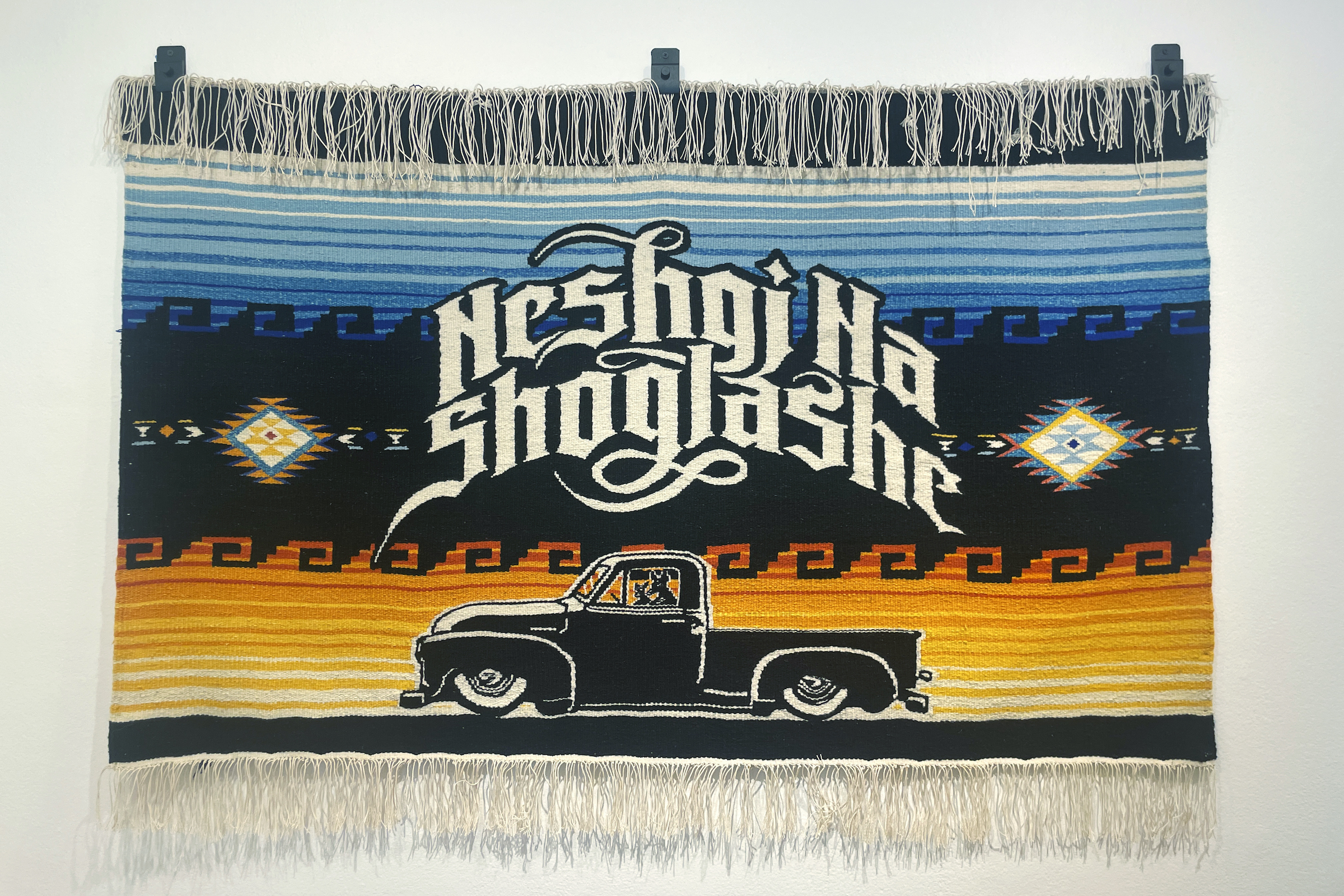LOS ANGELES — There’s something uncanny about the Pico Union street sign printed onto a black t-shirt. Its typeface doesn’t quite match the Highway Gothic stamped onto all standard roadsigns, giving it the aura of a bootleg. The circular canvas that frames the t-shirt invokes the wheel of a lowrider, a reading punctuated by three silver lug nuts that protrude from the surface. A web-like star of barbed wire branches out from the wheel, and a single rhinestone heart earring embellishes the shirt, along with a cartoonish boy in a spiky sombrero; a cut in the fabric reveals a swath of a Pro Club t-shirt featuring the Virgen de Guadalupe gazing downward with a sad expression.
Aaron Douglas Estrada’s “Pico Union” (2024) represents the urban and unapologetically Chicanx style that defines 3B Collective, which shines in its exhibition Highway Hypnosis at Craft Contemporary. 3B Collective, whose membership is continually in flux, is a group of Native and immigrant multidisciplinary artists for whom Los Angeles is part of their identity. They illustrate their affection for the city’s grittier iconography — lowrider culture, Dodgers fandom, gang colors, loose dogs — through traditional Mexican crafts, like ceramics and textiles, which are often fabricated by artisans in Latin America.
The exhibition blends symbolism with pop culture, building kinship with the audience. There’s joy in seeing Beemo, the anthropomorphic gaming console from Adventure Time, and an Oscar statuette alongside a Mayan glyph in Adrian Alfaro’s “Chunk” (2024) — or, for those who grew up between Mexico and Los Angeles, in recognizing the bikini models on the cover art for a type of dance music, cumbia, which Alexa Ramírez Posada has collaged over a fiberglass windshield cover in “Cucucucumbia” (2024).
The exhibition also conveys that 3B’s members are well versed in Euro-American art history. A series of acrylic paintings by Oscar Magallanes, A Study of a Study of Mexico (2021), riffs on Joseph Albers’s “Homage to the Square.” He paints in the same orange, yellow, and red colors Albers uses for “Study for Homage to the Square: Closing,” (1964), which evokes the stereotypically golden hues Hollywood slaps over Mexican landscapes. Magallanes’s series features four planar views of a ziggurat, shown from the X, Y, Z axes and at a three-quarter view, with the canvases cut to match the outline of the blocky structure. The last painting, the Z plane’s overhead view, is placed next to the Albers reproduction. The juxtaposition is funny: Maybe Albers was never painting squares at all, but was studying ziggurats. While the series might be a gag, it’s also a way of entering a region that’s considered to be part of the Global South into the White-dominated art historical canon.

3B Collective’s didactics continue the theme of subverting Western standards of art, by giving full credit to the craftspeople who have helped the artists. “Freeway Weaving” (2024), for example, is attributed to 3B Collective and Beto Ruiz, founder of the textile space Tallerocoho8 in Oaxaca. Ruiz’s traditional woven tapestry places 3B’s image of a freeway against a deeply saturated pink sky. The rich dyes were created with native plants. By recognizing creatives like Ruiz, 3B Collective exemplifies what a decolonial art practice can be: honoring all contributors rather than crediting one artist with sole authorship of a work.
Highway Hypnosis is a true depiction of Los Angeles’s Chicanx diaspora. Whether one was born in Boyle Heights or immigrated from Guadalajara, ties to the homeland define a tough identity that finds pride in barbed wire and cracked sidewalks.




3B Collective: Highway Hypnosis continues at Craft Contemporary (5814 Wilshire Boulevard, Mid-Wilshire, Los Angeles) through September 8. The exhibition was organized by 3B Collective.

